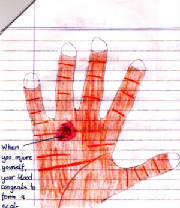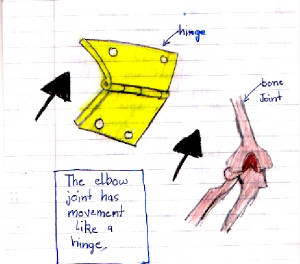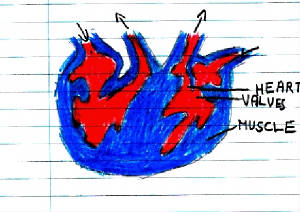|

|
| When you injure yourself, your blood congeals to form a scab |
THE BLOOD
By Arnavi Mehta
Blood is pumped
around your body by your heart and it travels through veins and arteries. Its job is to deliver food and oxygen to cells in
your body, and it also collects waste products from these cells.
An adult body
holds around 5 – 6 litres of blood, all of which is constantly pumping around your body. Your blood contains white and
red cells. The white cells help to fight infections by killing germs. The red cells (which give the blood its red colour)
transport the oxygen around your body.

BONES AND JOINTS
By
Arnavi Mehta
The skeleton is
the framework of the bones that hold us together. There are 206 bones in the adult body. More than 50 of these are found in
our hands ! They support our muscles and protect the important organs such as the heart and lungs within our rib cage.
Bones cannot
bend, and therefore where two bones meet they form joints. The joints within our bones are like hinges that join bones together
and allow bending, twisting movements. We also have joints in our elbows, knees, ankles and fingers, and we even have bones
in our ear.

THE HEART
By
Arnavi Mehta
The heart is a
special organ made of muscle which pumps blood to your lungs and to every part of your body except your hair and nails. The
arteries that leave your heart are the largest vessels, but most blood vessels are so narrow that you can hardly see them.
An adult has 5
– 6 litres of blood. The heart pumps most of this every minute, but it can pump up to 20 litres a minute if the person
is running fast.
When you are resting,
your heart beats about 60 – 80 times a minute, so it beats about 100,000 times a day. Every time the heart beats, it
can be felt as the pulse in different places in the body. The usual one is at the wrist.
*
*
*
*

THE STOMACH
By
Arnavi Mehta
The stomach churns
up everything we eat into a soup. Some salts, water and sugar are absorbed directly from the stomach into the blood. The rest
of the soup then passes into the small intestine where most of the remainder is absorbed.
The small intestine
is a 5 metre (16 ft) long tube. Valuable proteins and sugar go to the liver for storage. Unwanted foodstuffs are treated by
the liver and some are got rid of (excreted) by the kidneys to the bladder in the urine and some pass through the intestines
unaltered and are got rid of this way.
……………………………..
THE LUNGS
By Vrinda Gangwal
If you stopped
breathing for more than a minute or two, you would quickly die. Breathing provides your blood with the oxygen from the air
that is vital to the survival of every body cell. Just as fire burns only if there is plenty of oxygen, so body cells break
down the food they also get from the blood. Without oxygen, brain cells live only a few minutes – which is why the brain
is quickly damaged if the heart stops pumping blood.
Facts about
breathing:
Nose and
throat – Normally, you breathe through your nose – although you can also breathe through your throat, through
a pipe called .. the pharynx at the top, the larynx in the middle and the trachea at the bottom.
Airways
– The lungs are like hollow trees with hundreds of branching airways called bronchioles
Air sacs
– Around the end of each bronchiole are a cluster of air sacs called alveoli, like bunches of grapes
………………………………………………………….
|
